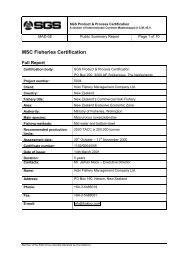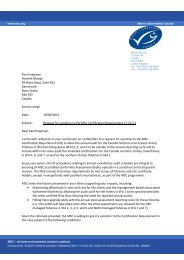SGS Product & Process Certification - Marine Stewardship Council
SGS Product & Process Certification - Marine Stewardship Council
SGS Product & Process Certification - Marine Stewardship Council
You also want an ePaper? Increase the reach of your titles
YUMPU automatically turns print PDFs into web optimized ePapers that Google loves.
Client Action<br />
Plan<br />
Condition 3<br />
Fishery specific<br />
management<br />
system<br />
preferably also account for other fishing metiers targeting sea<br />
bass, such as trawling and gill net fishing.<br />
The Client should also formulate management objectives for the<br />
sea bass fishery within the VBHL management plan.<br />
Timescale: By first surveillance audit, written evidence is required<br />
of appropriate action by the client to encourage the relevant<br />
management authorities to formulate management objectives for<br />
this fishery, and to demonstrate that a management objective for<br />
the sea bass fishery is incorporated within the VBHL management<br />
plan.<br />
Liaise with authorities and scientists to develop specific fishery<br />
objectives and implement these objectives within the VBHL<br />
management plan<br />
3.2.2 Decision making process<br />
P3 The fishery-specific management system includes effective<br />
decision making processes that result in measures and strategies<br />
to achieve the objectives.<br />
SG 60 There are informal decision-making processes that result in<br />
measures and strategies to achieve the fishery-specific objectives.<br />
Decision-making processes respond to serious issues identified in<br />
relevant research, monitoring, evaluation and consultation, in a<br />
transparent, timely and adaptive manner and take some account of<br />
the wider implications of decisions.<br />
SG 80 There are established decision-making processes that result in<br />
measures and strategies to achieve the fishery-specific objectives.<br />
Decision-making processes respond to serious and other important<br />
issues identified in relevant research, monitoring, evaluation and<br />
consultation, in a transparent, timely and adaptive manner and<br />
take account of the wider implications of decisions.<br />
Decision-making processes use the precautionary approach and<br />
are based on best available information.<br />
Explanations are provided for any actions or lack of action<br />
associated with findings and relevant recommendations emerging<br />
from research, monitoring, evaluation and review activity.<br />
SG 100 Decision-making processes respond to all issues identified in<br />
relevant research, monitoring, evaluation and consultation, in a<br />
transparent, timely and adaptive manner and take account of the<br />
wider implications of decisions.<br />
Formal reporting to all interested stakeholders describes how the<br />
Page 51 of 151





